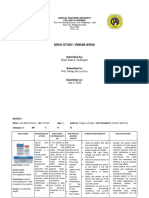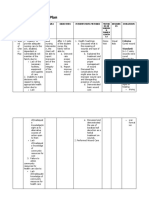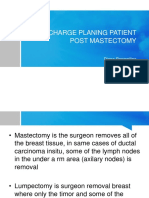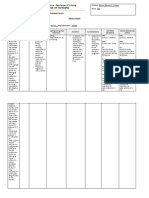Drugstudy For Elderly
Drugstudy For Elderly
Uploaded by
JenniferP.BarrosoCopyright:
Available Formats
Drugstudy For Elderly
Drugstudy For Elderly
Uploaded by
JenniferP.BarrosoOriginal Title
Copyright
Available Formats
Share this document
Did you find this document useful?
Is this content inappropriate?
Copyright:
Available Formats
Drugstudy For Elderly
Drugstudy For Elderly
Uploaded by
JenniferP.BarrosoCopyright:
Available Formats
V.
DRUG STUDY MULTIVITAMINS + ZINC Name of Drug Generic (Brand) Multivitamins + Zinc (Vigor Ace) Classification Dose/ Frequency/ Route 1 cap OD PO Mechanism of Action Vigor-ACE provides the synergistic actions of protective biologic antioxidants: Vitamins C and E, and selenium. Vitamin E protects the cell membranes against damage by preventing the formation of lipid hydroperoxides. Vitamin C and the seleniumcontaining enzyme, glutathione peroxidase, inactivate these oxidizing agents, thus maintaining the integrity and stability of the cell membrane structures. Vigor-ACE also provides vitamin A and zinc to help stimulate and maintain nucleoprotein synthesis which is important in Indication Contraindication Side Effects Nursing Precaution May be taken with or without food (May be taken w/ meals for better absorption). Use in pregnancy: The safety of routine use of >6000 units of vitamin A daily and selenium supplementation in pregnant women has not been established.
Vitamins and/or Minerals
Nutritional supplement to support active functioning in adults & to help restore vitality in aging & convalescing patients.
cellular maintenance and repair. The incorporation of lecithin, a lipotropic agent, in Vigor-ACE, supports normal functioning of the cells by enhancing the mobilization of fats and their subsequent conversion into energy or specific tissue elements. Combining specific cellprotective and nutrient factors, once-a-day VigorACE helps restore and maintain general wellbeing, strength and vitality.
V. DRUG STUDY CIPROFLOXACIN Name of Drug Generic (Brand) Ciprofloxacin Classification Dose/ Frequency/ Route 200 mg/ q 12o No test IV Mechanism of Action Ciprofloxacin promotes breakage of double-stranded DNA in susceptible organisms and inhibits DNA gyrase, which is essential in reproduction of bacterial DNA. Indication Contraindication Side Effects Nursing Precaution May be taken with or without food. (May be taken w/ meals to minimize GI discomfort. Do not take w/ antacids, Fe or dairy products.) Epilepsy, history of CNS disorders; severe renal or hepatic dysfunction; G6PD deficiency; maintain adequate hydration; myasthenia gravis. Caution when used in patients with QT prolongation or risk factors e.g. bradycardia, preexisting cardiac disease or uncorrected electrolyte disturbances. Discontinue treatment if patients experience tendon pain, inflammation or rupture. Avoid usage in methicillin-
Antibiotic (Quinolones)
Susceptible infections
Hypersensitivity. Not to be used concurrently with tizanidine. Avoid exposure to strong sunlight or sun lamps during treatment.
GI disturbances; headache, tremor, confusion, convulsions; rashes; joint pain; phototoxicity. Transient increases in serum creatinine. Haematological, hepatic and renal disturbances. Vasculitis, pseudomembranous colitis and tachycardia. Phototoxicity. Potentially Fatal: Anaphylactoid reaction; cardiopulmonary arrest.
resistant staphylococcus aureus (MRSA) infections due to high level of resistance. May impair ability to drive or operate machinery. Safety and efficacy have not been established in pregnant and lactating women. Not to be used in children <18 yr; except where benefit clearly exceeds risk.
V. DRUG STUDY TRIMETAZIDINE Name of Drug Generic (Brand) Trimetazidine Classification Dose/ Frequency/ Route 35 mg 1 tab BID PO Mechanism of Action Trimetazidine is a cellular acting anti-ischemic agent. It has 3 main properties by which it acts as a cytoprotective agent. It inhibits the anaerobic glycolysis and fatty acid metabolism, thus allowing only aerobic glycolysis. This action helps to restore the energy balance in the cell. It inhibits acidosis and free radical accumulation in the cell. All these action help the cell to restore the normal ionic and metabolic balance. Indication Contraindication Side Effects Nursing Precaution Should be taken with food.
Anti-Anginal Drugs
Angina pectoris
Hypersensitivity. Pregnancy and lactation.
GI disturbances, vomiting, nausea.
V. DRUG STUDY ASA (ACETYLSALICYLIC ACID) Name of Drug Generic (Brand) Acetylsalicylic acid (Aspilet) Classification Dose/ Frequency/ Route 80 mg 1 tab OD PO Mechanism of Action Platelet aggregation inhibitors excluding heparin. Indication Contraindication Side Effects Nursing Precaution Should be taken with food (Take immediately after meals w/ a full glass of water unless patient is fluid-restricted. Swallow whole, do not chew/ crush/ bite the tab. ). Heavy alcohol consumption. Hemophilia, vit K deficiency or liver disease. Do not use 1 wk prior to & during labor, delivery & any surgery. Severe renal & hepatic insufficiency. 3rd trimester of pregnancy & lactation. Avoid use in childn or teenagers for viral infections w/ or w/o fever for risk of Reye's syndrome.
Anticoagulants, Antiplatelets & Fibrinolytics (Thrombolytics)
Reduction of atherosclerotic events (MI, stroke or vascular death) in patients w/ atherosclerosis documented by recent stroke, MI or established peripheral arterial disease.
Asthma, rhinitis & nasal polyps. History of active peptic ulcer disease. Hypersensitivity.
Fever, hypothermia, thirst. Dysrhythmias, hypotension, tachycardia. Agitation, cerebral edema, coma, confusion, dizziness, headache, subdural or intracranial hemorrhage, lethargy, seizures. Dehydration, hyperkalemia, metabolic acidosis, resp alkalosis, dyspepsia, GI bleeding, ulceration & perforation, nausea, vomiting, transient hepatic enzyme elevations, hepatitis, Reye's syndrome, pancreatitis. Prolongation of prothrombin time, disseminated intravascular coagulation, coagulopathy, thrombocytopenia. Acute anaphylaxis, angioedema, asthma, bronchospasm, laryngeal edema, urticaria. Hearing loss, tinnitus.
Prolonged pregnancy & labor, stillbirths, low birth wt infants, antepartum & postpartum bleeding. Hyperpnea, pulmonary edema, tachypnea. Interstitial nephritis, papillary necrosis, proteinuria, renal insufficiency & failure. Rhabdomyolysis. Hypo/hyperglycemia.
V. DRUG STUDY CETIRIZINE Name of Drug Generic (Brand) Cetirizine Classification Dose/ Frequency/ Route 10 mg tab OD at bedtime PO Mechanism of Action Cetirizine is a potent and highly selective antagonist of the peripheral histamine H1receptor on effector cells in the GI tract, blood vessels and respiratory tract. Indication Contraindication Side Effects Nursing Precaution Hepatic or renal impairment; elderly; tasks requiring mental alertness eg, driving or operating heavy machinery; pregnancy.
Antihistamines & Antiallergics
Allergic conditions
Hypersensitivity; lactation.
Somnolence, insomnia, malaise, headache, dizziness; GI discomfort, dry mouth, abdominal pain, diarrhoea, nausea, vomiting; occasional hypersensitivity; epistaxis, pharyngitis, bronchospasm.
V. DRUG STUDY FERROUS + FOLATE Name of Drug Generic (Brand) Ferrous + folate (Fortifer FA) Classification Dose/ Frequency/ Route 1 cap OD PO Mechanism of Action Indication Contraindication Side Effects Nursing Precaution Should be taken on an empty stomach (Best taken between meals. May be taken w/ meals to reduce GI discomfort.).
Vitamins & Minerals / Antianemics
Prevention & treatment of Fedeficiency anemia & folate deficiency
GI irritation.
V. DRUG STUDY CIPROFLOXACIN Name of Drug Generic (Brand) Ciprofloxacin Classification Dose/ Frequency/ Route 500 mg 1 tab/cap BID PO Mechanism of Action Ciprofloxacin promotes breakage of double-stranded DNA in susceptible organisms and inhibits DNA gyrase, which is essential in reproduction of bacterial DNA. Indication Contraindication Side Effects Nursing Precaution May be taken with or without food. (May be taken w/ meals to minimize GI discomfort. Do not take w/ antacids, Fe or dairy products.) Epilepsy, history of CNS disorders; severe renal or hepatic dysfunction; G6PD deficiency; maintain adequate hydration; myasthenia gravis. Caution when used in patients with QT prolongation or risk factors e.g. bradycardia, preexisting cardiac disease or uncorrected electrolyte disturbances. Discontinue treatment if patients experience tendon pain, inflammation or rupture. Avoid usage in methicillin-
Antibiotic (Quinolones)
Susceptible infections
Hypersensitivity. Not to be used concurrently with tizanidine. Avoid exposure to strong sunlight or sun lamps during treatment.
GI disturbances; headache, tremor, confusion, convulsions; rashes; joint pain; phototoxicity. Transient increases in serum creatinine. Haematological, hepatic and renal disturbances. Vasculitis, pseudomembranous colitis and tachycardia. Phototoxicity. Potentially Fatal: Anaphylactoid reaction; cardiopulmonary arrest.
resistant staphylococcus aureus (MRSA) infections due to high level of resistance. May impair ability to drive or operate machinery. Safety and efficacy have not been established in pregnant and lactating women. Not to be used in children <18 yr; except where benefit clearly exceeds risk.
V. DRUG STUDY OMEPRAZOLE Name of Drug Generic (Brand) Omeprazole (Omepron) Classification Dose/ Frequency/ Route 20 mg 1 cap OD PO Mechanism of Action Suppresses gastric secretion by inhibiting hydrogen/potassium ATPase enzyme system in the gastric parietal cell: characterized as gastric acid pump inhibitor, since it blocks the final step of acid production. Indication Contraindication Side Effects Nursing Precaution Symptomatic response to therapy does not rule out presence of gastric malignancy. Pregnancy & lactation. If patient will experience anorexia, small frequent meals may help maintain adequate nutrition. Caution patient to avoid alcohol, salycilates, ibuprofen: may cause GI irritation.
Antacids, Antireflux Agents & Antiulcerants
Active duodenal ulcer & GERD w/ erosive esophagitis
Hypersensitivity to omeprazole or to any components of Omepron. Lactation and children. Combination therapy with clarithromycin should not be used in patients with hepatic impairment.
Constipation, diarrhea, flatulence, nausea, vomiting & acid regurgitation. Abdominal pain, asthenia, headache, dizziness, rash.
V. DRUG STUDY RADIX GENTIANAE Name of Drug Generic (Brand) Radix Gentianae (Sinupret) Classification Dose/ Frequency/ Route 1 tab TID PO Mechanism of Action Indication Contraindication Side Effects Nursing Precaution May be taken with or without food
Other Drugs Acting on the Respiratory System
Acute & chronic inflammations of the sinuses & the resp tract; supplementary measure in antibacterial therapy.
None known to date.
Hardly ever, stomach intolerance.
V. DRUG STUDY ISOSORBIDE MONONITRATE Name of Drug Generic (Brand) Isosorbide Mononitrate Classification Dose/ Frequency/ Route Mechanism of Action Isosorbide mononitrate relaxes vascular smooth muscles by stimulating cyclicGMP. It decreases left ventricular pressure (preload) and arterial resistance (afterload). Indication Contraindication Side Effects Nursing Precaution Should be taken on an empty stomach (i.e. At least one hour before food or two hours after food). Severe renal or severe hepatic impairment, hypothyroidism, malnutrition, or hypothermia. Caution in patients who are already hypotensive. May aggravate angina caused by hypertrophic cardiomyopathy. Tolerance may develop after longterm treatment. Lactation.
Anti-Anginal Drugs
Long-term management of angina pectoris and heart failure.
Severe hypotension or anaemia, hypovolaemia, heart failure due to obstruction, or raised intracranial pressure due to head trauma or cerebral haemorrhage.
Hypotension, tachycardia, flushing, headache, dizziness, palpitation, syncope, confusion. Nausea, vomiting, abdominal pain. Restlessness, weakness and vertigo. Dry mouth, chest pain, back pain, oedema, fatigue, abdominal pain, constipation, diarrhoea, dyspepsia and flatulence. Potentially Fatal: Severe hypotension and cardiac failure.
You might also like
- Marquez - Case Study 122Document5 pagesMarquez - Case Study 122Caren MarquezNo ratings yet
- Emj Cases : Questions For Case 1Document8 pagesEmj Cases : Questions For Case 1Azmyza Azmy100% (1)
- Clinical Reasoning Questions - CollaborationDocument4 pagesClinical Reasoning Questions - CollaborationMohammad OmarNo ratings yet
- Discharge PlanDocument4 pagesDischarge PlanJennyLapitanNo ratings yet
- DR Jaban Moore How Do I Know If I Have ParasitesDocument9 pagesDR Jaban Moore How Do I Know If I Have ParasitesViolet VioletNo ratings yet
- Veterinary Epidemiology (VEP-411)Document15 pagesVeterinary Epidemiology (VEP-411)Vijay Kumar Anumolu100% (1)
- Multiple Physical Injuries Secondary To Vehicular AccidentDocument31 pagesMultiple Physical Injuries Secondary To Vehicular AccidentAnton Laurenciana50% (2)
- Case Study of ParanoiaDocument2 pagesCase Study of ParanoiaNsengimana Eric MaxigyNo ratings yet
- Case Study Peralta (Drug N NCP)Document10 pagesCase Study Peralta (Drug N NCP)Trisha Cruise100% (1)
- Nursing Care Plan - EVALUATION PHASEDocument3 pagesNursing Care Plan - EVALUATION PHASEChezka Orton Swift BolintiamNo ratings yet
- Xii. Drug StudyDocument2 pagesXii. Drug StudyAela Maive MontenegroNo ratings yet
- RISK For INJURY Related To Regulatory Function (Sensory Difunction As Evidenced by Decrease Visual Acuity, Unable To Recognize Object 12-14 Inches Away, Not Wearing of Eyeglasses.Document2 pagesRISK For INJURY Related To Regulatory Function (Sensory Difunction As Evidenced by Decrease Visual Acuity, Unable To Recognize Object 12-14 Inches Away, Not Wearing of Eyeglasses.Senyorita KHayeNo ratings yet
- Drug Study CHNDocument3 pagesDrug Study CHNelijahdale.guillergan-05No ratings yet
- Attapulgite PDFDocument1 pageAttapulgite PDFWindy Tonapa100% (1)
- Fluid Volume Deficit Related To Active Fluid Volume LossDocument3 pagesFluid Volume Deficit Related To Active Fluid Volume LossMelDred Cajes BolandoNo ratings yet
- Sample (Concept Map)Document1 pageSample (Concept Map)NMDNMSSDNo ratings yet
- Health Teaching Nursery BGHDocument7 pagesHealth Teaching Nursery BGHAmira Fatmah QuilapioNo ratings yet
- Opstres Maalox Benutrex-C Paracetamol Essentiale Forte BactidolDocument6 pagesOpstres Maalox Benutrex-C Paracetamol Essentiale Forte Bactidolpark nisseNo ratings yet
- Drug Study PonstanDocument1 pageDrug Study PonstanRainier IbarretaNo ratings yet
- Doxofylline: D 400 MG TabletsDocument33 pagesDoxofylline: D 400 MG TabletsBibek Singh Mahat100% (2)
- NCP 2Document2 pagesNCP 2Grace HullezaNo ratings yet
- Drug StudyDocument7 pagesDrug StudyLA GomezNo ratings yet
- Discharge Planning: By: Chin V. UlamDocument2 pagesDischarge Planning: By: Chin V. UlamChin Villanueva UlamNo ratings yet
- NCP Impaired Physical MobilityDocument1 pageNCP Impaired Physical MobilityLorraine Punla PanganNo ratings yet
- 4 Cefazolin Drug StudyDocument4 pages4 Cefazolin Drug Studyshadow gonzalezNo ratings yet
- Grand Case PresentationDocument59 pagesGrand Case PresentationRon Lucernas MayugaNo ratings yet
- Clinical Portrait Pertinent DataDocument9 pagesClinical Portrait Pertinent DataGermin CesaNo ratings yet
- Journal Summary For Surgery WardDocument1 pageJournal Summary For Surgery WardlordwinjohnbernardoNo ratings yet
- (Brand Name) & Date Ordered General Class and Family Specific IndicationDocument2 pages(Brand Name) & Date Ordered General Class and Family Specific IndicationNicole Grace VillegasNo ratings yet
- Family Nursing Care PlanDocument14 pagesFamily Nursing Care PlanTenth Ann ModanzaNo ratings yet
- Discharge Plan Methods InstructionsDocument5 pagesDischarge Plan Methods InstructionsKirk CabasaNo ratings yet
- Assessment Cva Verb1Document2 pagesAssessment Cva Verb1JhiLy 사랑의 케빈 우No ratings yet
- FNCPDocument2 pagesFNCPNursidar Pascual MukattilNo ratings yet
- Drug Action Indications Contraindications Adverse Reaction Nursing ConsiderationDocument2 pagesDrug Action Indications Contraindications Adverse Reaction Nursing ConsiderationEdmarkmoises ValdezNo ratings yet
- Discharge Planning EnglishDocument11 pagesDischarge Planning Englishrahmat hidayatNo ratings yet
- NCP - Risk For Other-Directed ViolenceDocument2 pagesNCP - Risk For Other-Directed ViolenceKasandra Dawn Moquia BerisoNo ratings yet
- Risk For Falls Aeb Loss of BalanceDocument4 pagesRisk For Falls Aeb Loss of BalanceAlexandrea MayNo ratings yet
- Cues Problem Physiologic Behavioral: Nutrition: Less Than Body Requirements Acute Pain Altered ADLDocument3 pagesCues Problem Physiologic Behavioral: Nutrition: Less Than Body Requirements Acute Pain Altered ADLAya BolinasNo ratings yet
- NCPDocument4 pagesNCPJoseph Dableo ParreñoNo ratings yet
- Drug Name Mechanism of Action Administration Indications Contraindications Adverse Reactions Nursing ResponsibilitiesDocument1 pageDrug Name Mechanism of Action Administration Indications Contraindications Adverse Reactions Nursing ResponsibilitiesIvan Liquiran AvenadoNo ratings yet
- Dinero, EM - Journal Reading - ERDocument3 pagesDinero, EM - Journal Reading - EREdreilyn ShienNo ratings yet
- Generic Name: Classification Indication:: Hema KDocument2 pagesGeneric Name: Classification Indication:: Hema KKristine YoungNo ratings yet
- Cefpodoxime Proxetil - Print VersionDocument5 pagesCefpodoxime Proxetil - Print Versionchristina_1990No ratings yet
- Npi NCMHDocument6 pagesNpi NCMHJoshua DauzNo ratings yet
- Drug StudyDocument4 pagesDrug StudyDanica AbayaNo ratings yet
- Ineffective Health Management Related To Mrs. Gama: Provide The Client Enough Knowledge About The ProblemDocument5 pagesIneffective Health Management Related To Mrs. Gama: Provide The Client Enough Knowledge About The ProblemAndrea Albester GarinoNo ratings yet
- Psychodynamics Part 1Document5 pagesPsychodynamics Part 1Nhicco Francis Abejuela100% (1)
- CeftriaxoneDocument1 pageCeftriaxoneleroux2890100% (2)
- Observe Patient's 10 Rights of Medication AdministrationDocument2 pagesObserve Patient's 10 Rights of Medication AdministrationRyan Paul BalotNo ratings yet
- SHN ObjectivesDocument3 pagesSHN Objectivescherie_92989No ratings yet
- Multiple AbrasionDocument10 pagesMultiple AbrasionChristian Ureta0% (1)
- Teaching Plan SampleDocument2 pagesTeaching Plan SampleJoe-Anne Eliz WillsNo ratings yet
- Nursing Care Plan: Cues Nursing Diagnosis Analysis Goal and Objectives Interventions Rationale EvaluationDocument3 pagesNursing Care Plan: Cues Nursing Diagnosis Analysis Goal and Objectives Interventions Rationale EvaluationCalimlim KimNo ratings yet
- Case (Acute Gastroenteritis) Group 4Document36 pagesCase (Acute Gastroenteritis) Group 4EljhayrosNo ratings yet
- Therapeutic Communication: Department of Health, PhilippinesDocument35 pagesTherapeutic Communication: Department of Health, PhilippinesKeith Clarence BunaganNo ratings yet
- Name of Drug Dosage, Route, Frequency and Timing Mechanism of Action Indication Adverse Reactions Special Precautions Nursing ResponsibilitiesDocument2 pagesName of Drug Dosage, Route, Frequency and Timing Mechanism of Action Indication Adverse Reactions Special Precautions Nursing ResponsibilitiesIvan Matthew SuperioNo ratings yet
- CHN Family HealthDocument4 pagesCHN Family HealthRose Athena SibalaNo ratings yet
- MannitolDocument3 pagesMannitolAlexandra AntondyNo ratings yet
- NCP FveDocument2 pagesNCP FveFortuna Grace AsuncionNo ratings yet
- Cellulitis Discharge PlanDocument1 pageCellulitis Discharge PlanJuvy Rose Tinga YeeNo ratings yet
- "Adayinalifeofanernurse": - Emergency-Room-NurseDocument2 pages"Adayinalifeofanernurse": - Emergency-Room-NurseGenevieve MundalaNo ratings yet
- NCP Allergic RhinitisDocument2 pagesNCP Allergic RhinitisNurhidaya Jumala AhangNo ratings yet
- Impaired MobilityDocument3 pagesImpaired MobilityYeana AlonNo ratings yet
- Ventricular Septal Defect, A Simple Guide To The Condition, Treatment And Related ConditionsFrom EverandVentricular Septal Defect, A Simple Guide To The Condition, Treatment And Related ConditionsNo ratings yet
- DM No. 123, S. 2021 Division Public Service Continuity Plan (PSCP)Document18 pagesDM No. 123, S. 2021 Division Public Service Continuity Plan (PSCP)JenniferP.BarrosoNo ratings yet
- Steroids A Diverse Class of Secondary MetabolitesDocument9 pagesSteroids A Diverse Class of Secondary MetabolitesJenniferP.BarrosoNo ratings yet
- 01 Draft DBM CHED JC Public ConsultationDocument8 pages01 Draft DBM CHED JC Public ConsultationJenniferP.BarrosoNo ratings yet
- 02 ANNEX I Evaluation Criteria Public ConsultationDocument6 pages02 ANNEX I Evaluation Criteria Public ConsultationJenniferP.BarrosoNo ratings yet
- MasterDocument65 pagesMasterJenniferP.Barroso0% (1)
- Cmo 35Document41 pagesCmo 35JenniferP.BarrosoNo ratings yet
- Org. Chem. Manual, 2013 PDFDocument53 pagesOrg. Chem. Manual, 2013 PDFSuyog patilNo ratings yet
- Drugstudy For NicuDocument10 pagesDrugstudy For NicuJenniferP.Barroso100% (3)
- Doctor's Orders SepsisDocument1 pageDoctor's Orders SepsisJenniferP.BarrosoNo ratings yet
- Miasm ConsolidatedDocument72 pagesMiasm ConsolidatedSatyendra RawatNo ratings yet
- Research Methodology in Dentistry: Part I - The Essentials and Relevance of ResearchDocument8 pagesResearch Methodology in Dentistry: Part I - The Essentials and Relevance of ResearchRomNo ratings yet
- Pharmacist StudyDocument100 pagesPharmacist StudyPrajakta ModiNo ratings yet
- NeoplasiaDocument150 pagesNeoplasiaDavon Richard Walter Van-VeenNo ratings yet
- Common Neonatal DisordersDocument70 pagesCommon Neonatal DisordersKiran Khasa100% (4)
- Week 8Document3 pagesWeek 8Francisco100% (1)
- Discharge Summary 1Document3 pagesDischarge Summary 1Anonymous ryyOAmhxBNo ratings yet
- Everest Pharmacy Lists 2022 PDFDocument13 pagesEverest Pharmacy Lists 2022 PDFSuraj PatilNo ratings yet
- Soap Note 2 Alyssa MatulichDocument8 pagesSoap Note 2 Alyssa Matulichapi-456313554No ratings yet
- Heavy Water Board Job Notification - Scientific Officer, Scientific Asst PostsDocument7 pagesHeavy Water Board Job Notification - Scientific Officer, Scientific Asst PostsCareerNotifications.comNo ratings yet
- Company ProfileDocument26 pagesCompany ProfilePintu Bhushan MitraNo ratings yet
- Negative Pressure Wound Therapy Where Are We In.5Document7 pagesNegative Pressure Wound Therapy Where Are We In.5Sisay GirmaNo ratings yet
- Proposal Form J Arogya T-903Document13 pagesProposal Form J Arogya T-903anurag655No ratings yet
- Neonatal Adaptation - GDS-K3.1 LalalalDocument36 pagesNeonatal Adaptation - GDS-K3.1 LalalalsridhaniNo ratings yet
- Health Powerpoint 2nd DayDocument20 pagesHealth Powerpoint 2nd Daylei man-onNo ratings yet
- Nursing Management of AmoebiasisDocument2 pagesNursing Management of Amoebiasisjiedysy100% (1)
- Effect of Physical Activity On Cognitive Function PDFDocument14 pagesEffect of Physical Activity On Cognitive Function PDFBrayan Esneider Mendoza ForeroNo ratings yet
- Intervenções Fundamentais em Cirurgia: Diérese, Hemostasia e Síntese Fundamental Interventions in Surgery: Dieresis, Hemostasis and SynthesisDocument21 pagesIntervenções Fundamentais em Cirurgia: Diérese, Hemostasia e Síntese Fundamental Interventions in Surgery: Dieresis, Hemostasis and SynthesisLuiz EduardoNo ratings yet
- Pengaruh Fisioterapi Dada Terhadap Perbaikan Klinis Pada Anak Dengan Pneumonia Desak Putu Kristian PurnamiasihDocument12 pagesPengaruh Fisioterapi Dada Terhadap Perbaikan Klinis Pada Anak Dengan Pneumonia Desak Putu Kristian PurnamiasihBismillah BismillahNo ratings yet
- Hard Health For WomenDocument3 pagesHard Health For Womenmeeka1982No ratings yet
- Scholarship Information and RequirementsDocument6 pagesScholarship Information and RequirementsSunni HemingsenNo ratings yet
- Brain Injury 2014Document356 pagesBrain Injury 2014sandykumala100% (1)
- Herpes VirusesDocument6 pagesHerpes VirusesAlya Putri KhairaniNo ratings yet
- 2nd Semester Reflective JournalsDocument12 pages2nd Semester Reflective Journalsapi-248017509No ratings yet
- Abdomenul AcutDocument5 pagesAbdomenul Acutcristina ovidenieNo ratings yet

































































































